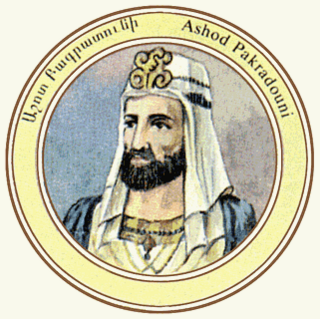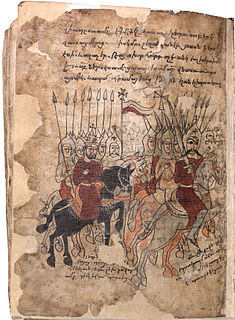Related Research Articles

Rshtuni was an old Armenian noble house which ruled the region of Rshtuniq who were purportedly descendants of Rusas I of Urartu.

René Grousset was a French historian, curator of both the Cernuschi and Guimet Museums in Paris, and a member of the prestigious Académie française. He wrote several major works on Asiatic and Oriental civilizations, with his two most important works being Histoire des croisades et du royaume franc de Jérusalem (1934–1936) and The Empire of the Steppes: A History of Central Asia (1939), both of which were considered standard references on the subject.

Ashot I was an Armenian king who oversaw the beginning of Armenia's second golden age. He was known as Ashot the Great and was the son of Smbat VIII the Confessor and was a member of the Bagratuni Dynasty.
Khosrov III the Small was a Prince who served as a Roman Client King of Arsacid Armenia.

Sasanian Armenia, also known as Persian Armenia and Persarmenia, may either refer to the periods in which Armenia was under the suzerainty of the Sasanian Empire or specifically to the parts of Armenia under its control such as after the partition of 387 when parts of western Armenia were incorporated into the Roman Empire while the rest of Armenia came under Sasanian suzerainty but maintained its existing kingdom until 428.

Mushegh I Mamikonian was an Armenian military officer from the Mamikonian family, who occupied the hereditary office of sparapet (generalissimo) of the Kingdom of Armenia under the Arsacid kings Pap and Varazdat. He took part in the Armenian resistance against the forces of the Sasanian monarch Shapur II, notably taking part in the Battle of Bagavan, where the Iranian forces were defeated. He was the regent of Armenia under the young and inexperienced Varazdat, who eventually suspected him of posing a danger to his rule, and thus had him executed, in 377/8.

The Battle of Bagavan or the Battle of Vagabanta, was fought in 371, on the plain of Bagrevand, with the Roman-Armenian armies defeating the Sasanid forces.
Veh Mihr Shapur was a Sasanian military officer and the first Marzban of Armenia from 428 to 442. Veh Mihr Shapur died in 442 and was succeeded by Vasak of Syunik.

Vahan Mamikonian was an Armenian nobleman from the Mamikonian family. In 481 he rebelled against the Sasanian Empire that controlled the eastern part of Armenia known as Persian Armenia. He was appointed as marzban (governor) of Persian Armenia in 485 and remained in that post until his death around 503-510.
Adhur Gushnasp was the marzban ("margrave") of the Sasanian province of Armenia from 465 to 482. He was killed during the Armenian rebellion of 482–484, and replaced by Sahak II Bagratuni.
Vard Mamikonian was an Armenian nobleman from the Mamikonian family. He served as the marzban of Persian Armenia from 505/510 to 509/514.
Zarmihr Hazarwuxt was an Iranian military leader from the House of Karen, who served as the marzban of Sasanian Armenia briefly in 483.
Varsken was an Iranian prince from the Mihranid family of Gugark, who served as the bidaxsh (margrave) of the region from 470 to 482. He was the son and successor of Arshusha II.
Varazdat, was an Iranian nobleman who served as the marzban of Persian Armenia from 560 to 564. During his governorship, Armenia was relatively peaceful. In 561, the Sasanian Empire and the Byzantine Empire, concluded a peace treaty known as the "Fifty-Year Peace Treaty", which ended the Lazic War. In 564, Varazdat was succeeded by Chihor-Vishnasp.
Shapur Mihran, known in Armenian sources as Shapuh Mihran, was a Sasanian nobleman from the House of Mihran. He served as the marzban of Persian Armenia briefly in 482.
Sahak II Bagratuni, was an Armenian nobleman from the Bagratuni Dynasty. He served as the marzban of Persian Armenia briefly in 482.
Mjej I Gnuni, was an Armenian nobleman from the Gnuni family, who served as the marzban of Persian Armenia from 518 to 548.

Katranide was the first Queen of the Bagratid Kingdom and member of the Bagratuni Dynasty. She was the wife of the first Bagratuni king - Ashot the Great (885-890). Katranide is known for her khachkar (879), which is situated in Garni, Armenia.
Shapur of Ray was a Sasanian military officer from the Mihran family. The city Ray in his name was the seat of the Mihran family.
References
- ↑ ( Grousset 1947 , pp. 242–247).
- ↑ ( Toumanoff 1990 , pp. 506–507).